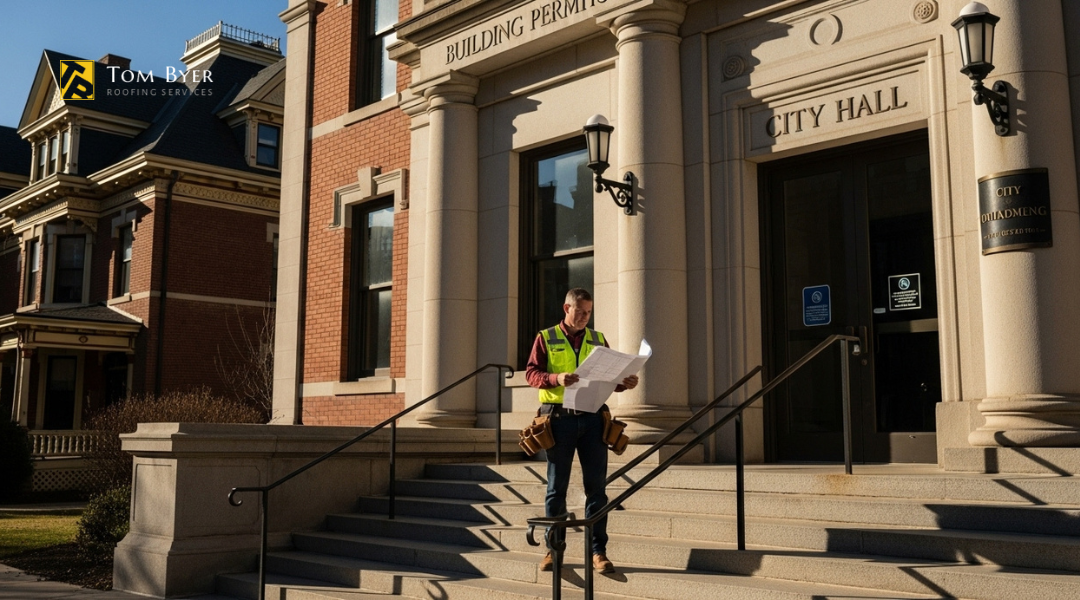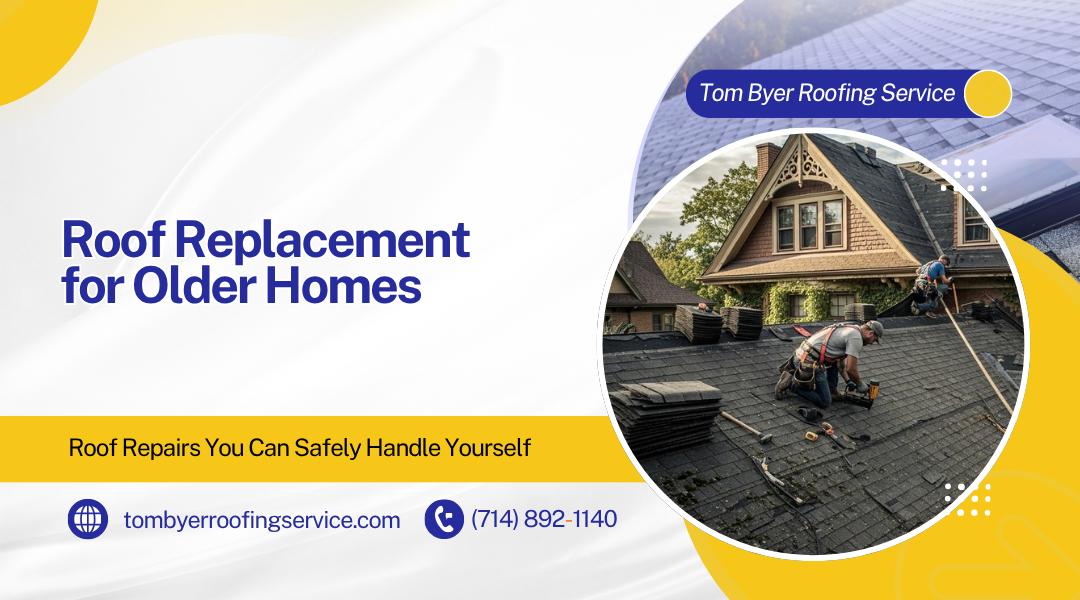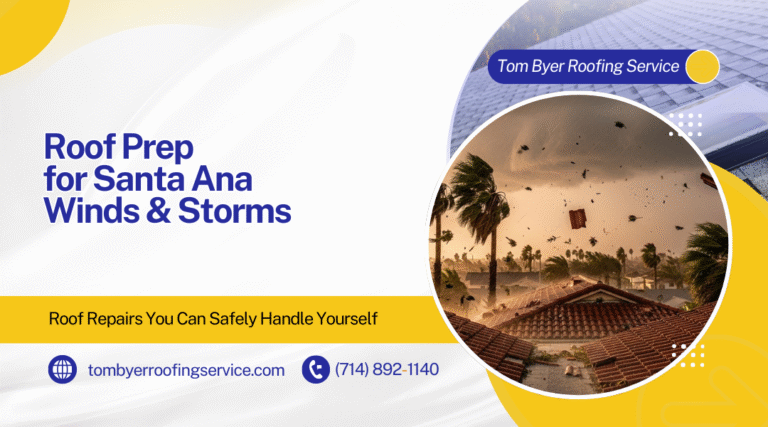Replacing the roof on an older home can present unique challenges. Many homeowners may worry about how to upgrade their roofs while preserving the character of their houses. Understanding these challenges and knowing the solutions can make the roof replacement process smoother and more efficient.
You might face issues like outdated roofing materials, structural concerns, or compliance with local building codes. Each of these factors can complicate the replacement process. However, using the right expertise, such as that offered by Tom Byer Roofing Service, can help you navigate these challenges effectively. With decades of experience, this trusted roofing contractor in Garden Grove is equipped to provide tailored solutions that meet the specific needs of older homes.
Choosing a professional service for your roof replacement ensures that your new roofing system will enhance your home’s durability and value. You can expect not only quality workmanship but also guidance on the best materials suited for your property. By investing in a reliable roof replacement, you are safeguarding your home against California’s diverse weather conditions while maintaining its charm.
Common Challenges in Replacing Roofs on Older Homes
Replacing roofs on older homes comes with unique challenges. These issues often stem from the age of the building, outdated materials, and hidden damage that may not be immediately visible. You need to be aware of these problems to ensure a successful roofing project.
Structural Issues and Weakened Framework
Older homes may have structural issues due to age and wear. As time passes, wooden beams can weaken, leading to a sagging roof. You might also find that the existing framework does not support modern roofing materials.
Before installation, a thorough inspection is necessary. Look for signs of cracking, warping, or any decay. If you notice these issues, additional reinforcement may be needed. This could raise your project’s cost and timeline but is essential for a roof that will last.
Outdated Roofing Materials and Building Codes
Many older homes were built with materials that are no longer compliant with current building codes. Common materials like asphalt shingles can become damaged or ineffective over time. You may find curling or cracked shingles that indicate the need for replacement.
Understanding local building codes is crucial. These laws are meant to ensure safety and durability. If your home has outdated materials, you will need to replace them with modern alternatives that meet current standards.
Hidden Damage – Mold, Rot, and Water Infiltration
Hidden damage is one of the most concerning issues in older homes. Mold, rot, and water infiltration can occur beneath the surface, often going unnoticed until significant damage has occurred. This can lead to serious problems with both your roof and your home’s interior.
As part of your roofing project, you should investigate for any signs of leaks. Water stains on ceilings or walls can indicate trouble. If mold is detected, professional remediation may be necessary before any roofing work begins.
Limited Load-Bearing Capacity for Modern Materials
Older homes often lack the load-bearing capacity needed for modern roofing materials. As building techniques have advanced, newer materials are generally heavier and require stronger support. You will need to assess if your home’s structure can accommodate these new options.
If your roof needs an upgrade in materials, reinforcing the framework could be necessary. This can involve adding new supports or beams. While these changes might seem daunting, they are essential for safely installing a new roof.
Assessing the Condition of an Older Roof
Assessing the condition of an older roof is crucial to determine if it needs replacement. Key signs of wear, the need for a professional inspection, and identifying underlying issues can help in making informed decisions.
Signs That Indicate a Roof Needs Replacement
Look for specific signs to help assess your roof’s condition. Common indicators include:
- Missing or Damaged Shingles: Look for shingles that are cracked, curling, or completely missing.
- Granule Loss: Check for an accumulation of granules in gutters. This can indicate that shingles are deteriorating.
- Leaks or Water Stains: Visible leaks inside your home or water stains on ceilings and walls signal potential roof issues.
- Mold and Mildew: Growth can indicate trapped moisture and may mean replacement is needed.
If you observe any of these signs, it’s essential to take action.
Importance of a Professional Roof Inspection
A professional roof inspection provides an expert evaluation of your roof’s condition. While you can do a visual check, professionals have the experience and tools to:
- Identify hidden damage you might miss.
- Assess the roof’s structural integrity.
- Recommend necessary repairs or replacement based on specific findings.
Regular inspections are vital in extending the life of your roof. Schedule a professional evaluation every few years, especially for older homes.
Identifying Underlying Structural Weaknesses
Beyond visible damage, structural weaknesses can affect your roof’s performance. Pay attention to:
- Sagging Areas: These may indicate weakened supports. Inspect the roof’s framing and decking.
- Ice Dams: Frequent ice buildup along eaves could lead to water infiltration. This condition requires careful inspection.
- Ventilation Issues: Poor ventilation can cause heat buildup and moisture problems, accelerating wear.
Addressing these issues early can save you from more extensive repairs or complete replacement later. Regular maintenance and prompt inspections are key to keeping your roof in good condition.
Choosing the Right Roofing Materials for Older Homes
Selecting the right roofing materials is crucial for older homes. You need to consider the home’s style, structure, and climate. It’s also essential to strike a balance between aesthetics and practicality.
Maintaining the Historic Integrity with Authentic Materials
To preserve the character of your older home, using authentic materials is vital. Options like wood shingles or tile roofs can enhance the home’s vintage appeal. Natural wood provides a classic look but requires periodic maintenance.

For many historic homes, metal roofing can also be a great choice. Materials like tin or zinc replicate the look of traditional roofs while offering improved durability. These materials help maintain the home’s historical features while ensuring structural integrity.
Lightweight Options for Weaker Roof Structures
Older homes often have weaker roof structures that can’t support heavy materials. In this case, asphalt shingles and metal roofs are suitable choices. Asphalt shingles are lightweight and come in various designs, making installation easier.
Metal roofing is another excellent lightweight option. It offers strength without adding significant weight to the structure. Plus, it lasts longer than traditional materials, providing you with better value over time.
Energy-Efficient and Sustainable Material Choices
You may want to consider energy efficiency when choosing roofing materials. Metal roofs have reflective properties that can reduce cooling costs in hot weather. They are also recyclable, making them an eco-friendly option.
Another sustainable choice is using asphalt shingles made from recycled materials. Their production process has become more energy-efficient, which helps lower your carbon footprint. Additionally, some wood shingles come from sustainably managed forests, promoting responsible sourcing.
By focusing on these aspects, you can select materials that enhance your home’s appearance and functionality.
Structural Reinforcement and Roof Preparation
Preparing your older home for a new roof involves careful structural reinforcement and roof preparation. This process ensures that your roof can handle the new materials and provides longevity to your roofing system.
Strengthening the Roof Deck and Framework
When replacing a roof, you must first inspect the roof deck and framework. This area needs to be strong enough to support new roofing materials. Look for signs of rot or damage, and replace any compromised sections.
Adding additional support beams can enhance stability. Ensure that all connections are secure and that the framing supports the weight evenly. If your framework is older, consider upgrading to modern materials that meet current building codes for enhanced support.
Upgrading Insulation and Ventilation for Longevity
Good insulation and ventilation are critical for any roof, especially in older homes. Check if your existing insulation is sufficient to prevent energy loss. Insulation not only keeps your home comfortable but also protects your roof from ice dams in winter.
Proper ventilation allows hot air to escape, reducing the chance of moisture buildup, which can lead to mold. Install vents at the ridge and soffits to promote airflow. A well-ventilated roof lasts longer and performs better under various weather conditions.
Addressing Drainage and Water Flow Issues
Effective drainage is essential when replacing a roof. Inspect gutters, downspouts, and valleys for clogs or damage. Properly functioning drainage prevents water from pooling, which can damage the roof and structure over time.
Consider installing larger gutters or additional downspouts if your current system cannot handle heavy rainfall. Ensure that the roof is sloped correctly to guide water away from your home’s foundation. Addressing these drainage needs can significantly extend the life of your new roof.
Navigating Permits and Building Code Compliance
Replacing the roof on an older home requires careful attention to permits and building codes. Understanding local regulations, meeting modern standards, and working with the right contractor are essential steps in this process.
Understanding Local Regulations for Older Homes
Local regulations can vary greatly when it comes to roofing on older homes. Many towns have preservation guidelines to maintain the historical integrity of these buildings.

You should start by checking with your local building department to learn about specific requirements.
Common regulations include restrictions on roofing materials and styles. For example, if your home is in a historic district, you might be required to use materials that match the original roof.
Make sure to gather this information before starting any work, as failure to comply can lead to fines.
Meeting Modern Safety and Energy Efficiency Standards
Even when working on an older home, it’s crucial to meet current safety and energy efficiency standards. Modern roofs often include requirements for fire resistance, wind resistance, and insulation.
Check for updated codes related to materials and methods, as older homes might not meet these new standards. For example, installing proper insulation can save you money on energy bills while making your home more comfortable.
Consider asking your contractor about energy-efficient roofing options, such as reflective materials that can reduce heat buildup in your attic.
Working with a Contractor Experienced in Historic Homes
Choosing a roofing contractor with experience in older or historic homes makes a significant difference. These contractors are familiar with the unique challenges you may face.
An experienced contractor can guide you through the permitting process and ensure compliance with all codes. They will also know how to preserve the character of your home while upgrading its roofing.
Before hiring a contractor, ask about their previous work with similar homes. Request references and check reviews for their expertise in handling unique roofing challenges.
Cost Considerations and Budgeting for a Roof Replacement
When planning to replace the roof on an older home, understanding the costs involved is crucial. It is important to consider various factors that influence these costs, explore financing options, and discover ways to save money without sacrificing quality.
Factors That Influence the Cost of Replacing an Older Roof
The cost of your roof replacement can vary based on several key factors.
- Material Choice: Different roofing materials have different price points. Asphalt shingles are generally more affordable, while materials like slate can be much more expensive.
- Roof Size: The larger the roof, the more materials will be needed, increasing the cost.
- Labor Costs: Prices can vary based on location and contractor experience. Always get multiple quotes.
- Old Roof Condition: If your existing roof has structural issues, extra repairs will add to your overall expense.
- Energy Efficiency: Installing energy-efficient roofing materials can reduce energy bills over time, making initial costs more justifiable.
Financing Options and Insurance Coverage
Financing options are available to help spread the cost of your roof replacement.
- Home Equity Loans: Using your home equity can provide a low-interest option.
- Personal Loans: These can offer quick funding. However, they may have higher interest rates than home equity loans.
- Insurance Claims: If the damage is due to weather or accidents, your homeowners insurance might cover some costs. Always check your policy.
- Payment Plans: Many roofing contractors offer payment plans that allow you to pay in installments.
Consulting with your insurance agent can clarify what is covered and what out-of-pocket costs you should anticipate.
Cost-Saving Tips Without Compromising Quality
You can save money on your roof replacement without cutting corners on quality.
- Off-Season Replacement: Schedule your replacement in the off-season when contractors may offer discounts.
- Get Multiple Estimates: Comparing quotes can uncover potential savings.
- Choose Affordable Materials: Research your options. Some mid-range materials offer good value without high costs.
- Improve Energy Efficiency: Investing in good insulation and ventilation can lower your energy bills, providing long-term savings.
- Maintain Your Roof: Regular maintenance can prolong roof life, reducing the need for costly replacements.
By being informed and proactive, you can manage your roofing costs effectively.
Conclusion
Replacing roofs on older homes can greatly enhance curb appeal. A new roof not only improves the visual appearance but also increases your home’s value and equity.
You may encounter challenges such as structural issues or outdated materials. It’s essential to work with a trusted contractor, like Tom Byer Roofing Service, who understands the unique needs of older homes.
Consider the types of materials that best suit your home’s style and climate. Options vary from traditional shingles to modern metal roofing.
Regular maintenance is vital. After installation, keep an eye on your roof to ensure it stays in good shape.
By addressing these challenges, you can transform your older home into a more attractive and valuable property. Replacing your roof is an investment that pays off in comfort and aesthetics while boosting your home’s equity.




